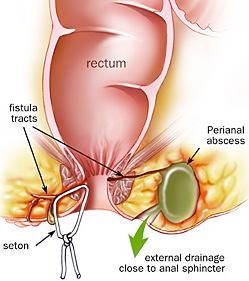Perianal Crohn’s Disease


Perianal Crohn’s Disease


Crohn’s of the perianal area
What is Crohn’s Disease?
Crohn’s disease is a chronic condition of the intestine characterized by inflammation of the intestinal wall. Along with another disease, Ulcerative Colitis, it is frequently referred to as Inflammatory Bowel Disease (IBD). The cause of it is not yet well understood, but it appears to be related to a complex interaction of environmental, immunological and genetic factors in affected individuals. It is an enormously complex and unpredictable disease that typically affects the small intestine, large intestine and perianal area.
What is Crohn’s disease of the anus (Perianal Crohn’s)
One of the unique aspects of Crohn’s disease (as distinct from Ulcerative Colitis) is that it can affect the anal area. Approximately 15-20% of people with Crohn’s disease of the small or large intestine also have perianal disease. And for some patients with Crohn’s disease, the perianal problems are the only manifestations of the disease. Perianal Crohn’s is characterized by the formation of abscesses, fistulae, large skin tags, and ulcers in and around the anus. Patients with perianal Crohn’s disease frequently have infections and drainage from the sores and openings around the anus. It can be very painful. Treatment of perianal Crohn’s is usually a combination of medical and surgical treatment.
Can you cure my perianal crohn’s?
The short answer is “No”. At least, not surgically. But along with medical treatment provided by a gastroenterologist (GI), we can help control it and make living with perianal crohn’s much better. Perianal Crohn’s disease is similar to a disease like rheumatoid arthritis. It cannot be cured, but with judicious use of medication and surgery, we can help you live reasonably comfortable with it. Medical treatment for Crohn’s disease can frequenly help put the perianal disease into remission for extended periods of time. But it rarely cures it.
Why see a Colon and Rectal Surgeon for Perianal Crohn’s?
Perianal Crohn’s represents a very specialized type of perianal disease. Patients are usually sent to colon and rectal surgeons (as opposed to general surgeons) for surgical management, because the disease can be very complex and may require multiple procedures and complex management.
What is the usual treatment for perianal Crohn’s disease?
Though everyone’s disease is slightly different, the general surgical principle of managing patients with perianal Crohn’s disease is to drain any infection and ensure that good drainage continues. This frequently means placement of a type of drain called a “Draining Seton”. A draining seton is usually a piece of silastic (like rubber) which goes around the fistula and ensures that there is always a way for infection to drain out. It is non-reactive, and does not damage the sphincter muscle or surrounding tissues. See the pictures and diagrams below. Seton drains can be left in for long periods of time (i.e., years) and provide a great deal of relief and comfort for most patients. One good drainage has been established, medications can be employed to help reduce the inflammation and settle the disease.


When will you take out the Seton drain?
As mentioned above, Setons are frequently left in place for extended periods of time, sometimes years. Medical treatment for perianal crohn’s has improved dramatically over the past 10 years or so and frequently can control the inflammation around the anus. If this occurs, the Seton can be easily removed, but this does not mean that the disease is cured and many patients end up needing setons again at some point.
Will I need a colostomy or ileostomy for perianal Crohn’s?
This is a tough question. The vast majority of patients with perianal crohn’s do not need a stoma (i.e., colostomy or ileostomy). But approximately 5-10% of patients with perianal Crohn’s do end up needing at least a temporary stoma to divert the stool and allow the perianal infection to settle down. This is usually because their Crohn’s disease does not respond well to surgical or medical treatment and they develop intractable infection and pain around the anus. Diverting the stool away with a stoma is likely removing the fuel for the fire and eventually the perianal infections settle down significantly.
More about Perianal Crohn’s
There is a great deal more that can be said about perianal Crohn’s disease. It is a complex condition involving the anus which can have a significant impact on many patients with Crohn’s disease. Medical treatments over the past 10 years have significantly improved the quality of life of many patients with perianal crohn’s and this will hopefully continue. But it still remains a challenging disease to treat. Many patients maintain a long term relationship with their colon and rectal surgeon.
